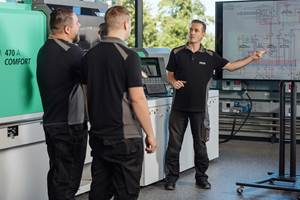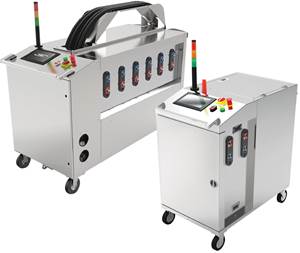Injection Molder Amplifies Automation for Optimized Production
AIM Processing has parlayed small part molding expertise and aggressive automation, even for short run production, into a highly successful custom molding business.

AIM Processing operates 37 injection molding machines, 35 of which are horizontal, with all of those outfitted with a Yushin robot. Source: AIM Processing
When Plastics Technology visits AIM Processing, Longmont, Colorado, at 10 a.m. on a Tuesday morning, 18 of the custom injection molder’s 37 presses are running, so finding an operating cell isn’t hard, but spotting people is a little trickier. Asked how many operators are currently on the floor, AIM President Jon Gelston answers four, before noting there are also two collaborative robots (cobots) tending machines.
Unlike people, spotting robots at AIM is not difficult with all 35 of the company’s horizontal all-electric injection molding machines outfitted with Yushin cartesian units. The only machines not paired with a permanent robot, for now, are AIM’s two vertical molding machines. In addition, there is the aforementioned pair of Universal Robots cobots, which are moved around the floor to various jobs, working in tandem with their fixed three-axis cousins. AIM’s intensive application of automation is not just about addressing the challenges of finding labor or blunting its cost impact, it’s about fortifying its competitive niche in small parts, as well as the knock-on benefits automation provides to production efficiency, capacity and quality.
“I think a lot of people start to go into automation addressing what they perceive as a labor problem or, specifically, the cost aspects of labor,” Gelston says, “and really what has been astounding for us is if you go into it addressing aspects of the manufacturing process — how to use the technology and how to use the training — the impacts are much, much farther reaching than that.”
Small Parts, Global Reach
Printed beneath the AIM Processing logo on its front door and the company’s business cards are the words “small part injection molding” — a market strategy the company has pursued since its founding in 1993. “We’re really focused on the size-of-a-hand-and-smaller type parts,” Gelston explains. The company makes about 1,400 different components for 120 customers, shipping output all around the world from its facility 30 miles north of Denver. “Small parts make it competitive to ship,” Gelston says. “You can be competitive on a global scale with a global supply chain.” About 40% of AIM’s business is in electronics, 40% in medical and noninvasive medical, with the remaining portion in industrial applications.

AIM Processing designs and builds its own end-of-arm-tools, according to Gelston, creating an in-house store of components for a “grown-up Erector set.” Source: AIM Processing
A Molder’s Molder
“Actually the company started out as really a molder’s molder,” Gelston says. “We served as an outsource resource for small parts for some other shops, if they had a larger program and, in the end, we had a standalone business. Small parts have grown substantially since that time.”
Gelston took over AIM in 2006, and the company moved into its current building in 2014 with around 20 molding machines. AIM would repurpose and expand the space in 2022 from 40,000 to 60,000 square feet. Organic growth pushed it to 30 machines and then, as it fully embraced automation, the ability to take on secondary operations at the press robotically enabled it to convert most of its secondary operations space into additional molding capacity, getting the company to the 37 machines it runs today. The clamp force range of its fleet extends from 17 to 300 tons, but of its 37 machines, 30 are within the 55- to 110-ton range.
[Our suppliers] have been here many times, and every time, they tell me, ‘I don’t see anybody in custom molding doing automation at this level.’
As we tour the facility, AIM’s full embrace of automation is evident at every press. A trim component of a ski binding is molded and trimmed automatically, with the robot counting parts as it drops them into four boxes situated within a cage. This cage, which includes conveyors for staging the boxes capturing production, has a docking station at its base that ensures it is correctly integrated with the press. “No guesswork, no collisions,” Gelston explains, noting that all its automation cells and presses utilize the docking concept.

The replacement of an operator with a Universal Robots cobot boosted production for this insert molding operation, with the cobot staging metal inserts for the Yushin robot. Source: Plastics Technology
Beyond application of the docking poka-yoke, Gelston says AIM further ensures error-free setup and operation of automation via how it trains its operators. “Some companies just train an individual or two on automation,” Gelston says. “We’ve decided that to really make it happen in our environment, we wanted everybody to be trained. So, any of our shifts throughout the week, which is seven days for us, can set up automation equipment, write their own programs and start up robots.”
Next up, a 30-ton press is molding a noninvasive medical component, handling the part with a custom end-of-arm tool (EOAT) that includes a 3D-printed component. Across from this machine, the first of the two Universal Robots cobots is helping with an insert molding application. In the past, the job required an operator to wait through the 118-second molding cycle before undertaking the 2-second manual introduction of a metal insert. Because AIM didn’t always have an operator available, order fulfillment could take five days. For the last four years, thanks to the cobot, this job runs unattended in only four days. “This cobot will be doing something else on Thursday,” Gelston notes. Key here is the cobot’s ability to communicate with the Yushin robot, with the cobot removing the insert from a staging tray and then leaving it in a fixture for the Yushin to pick up and insert into the mold.
Next to a job that features full automation (despite a production run of just 700 pieces), AIM is molding a medical part that’s smaller than a dime and has 14 through holes the thickness of a human hair. Automation was added here for cavity separation on the four-cavity tool, eliminating the need for a full-time operator and enabling production to jump to 160 hours/week versus 40. “Automation can help increase your utilization,” Gelston explains. “From a capacity standpoint, there are machines that ordinarily we would just shut down at night because we wouldn’t have the same number of operators. Now we have increased running utilization of something, which increases our overall available capacity.”

A cobot outfitted with a camera to ensure proper orientation picks up plastic inserts for PUR overmolding. Source: Plastics Technology
Gelston notes that AIM’s use of automation is different from most molders, but not just in its comprehensive application. “If you look at a high-volume plant, like a facility molding toothbrush handles,” Gelston says, “our automation probably isn’t going to impress you. But when you look at it and say, ‘Well, they automated a job to make just 1,000 pieces,’ it’s a different story.”
AIM’s innovative automation strategy has made the biggest impression on its robotics vendors, who remain amazed despite numerous visits to its facility. “They’ve been here many times, and every time, they tell me, ‘I don’t see anybody in custom molding doing this at this level. Normally you only automate your 1 million unit a year jobs, right?’”
Finished Inventory as a Good Thing
In addition to automation, one thing AIM also has in abundance is inventory. COVID-19-fueled supply chain disruptions notwithstanding, manufacturing in general and injection molding in particular have long embraced a just-in-time strategy of molding parts as ordered and steadfastly avoiding any work in progress. At AIM, however, the company recently quadrupled its warehouse from 5,000 square feet to 20,000 square feet, and it gladly negotiates blanket-order stock agreements, with more than 80% of shipments fulfilled from stock. As we walk deeper into the expanded warehouse, overhead lights set with automatic motion sensors flicker on, revealing more and more rows of shelves and storage.
“A lot of people associate finished inventory as being a bad thing,” Gelston says, “but I look at it as an opportunity to delight customers. We’ve got available stock on things because we didn’t put any additional cost into it.” As Gelston points out during our tour, AIM pays for pellets at one end of the building but doesn’t add costs to them as they move through the facility to the warehouse and shipping. The initial investment in automation was steep, but as those assets are amortized and the added cost of human intervention with the parts is removed, the luxury of maintaining stock can be realized.

Jon Gelston acquired AIM Processing in 2006 growing it into one of the largest injection molders in mountain west since then.
“Some of these parts are really small, and we’ll basically set up one bin there, and it’s there for days and days and days, which for us, as a small part molder, is a differentiator,” Gelston says. “We can do things differently with automation.” While the machines run 24/7, on the weekends a skeleton staff is only on hand for 12 hours a day, as AIM shifts to lights-out production.
Gelston lays out how AIM and molders in general should and shouldn’t think about implementing more automation. “Some companies think, ‘Let me buy a robot and surely somebody will figure it out, right?’ You need to be thinking about it more from a technological architecture standpoint, which is, ‘How can I get better utilization out of my injection molding machines and my robots?’” Gelston says. “It’s by using them and figuring out how you can leverage your fixed investment in injection molding machines and robots in ways that, for a relatively low cost, allow you to start to automate those 1,000-piece jobs.”

AIM Processing maintains around 700 active tools, recently organizing them via Vidmar tool storage system. Source: AIM Processing
Related Content
Five Ways to Increase Productivity for Injection Molders
Faster setups, automation tools and proper training and support can go a long way.
Read MoreSystem Offers 'Lights Out' Mold-Channel Cleaning & Diagnostics
New system automatically cleans mold-cooling lines—including conformal channels—removing rust and calcium, among other deposits, while simultaneously testing for leaks, measuring flow rate and applying rust inhibitor.
Read MoreWhat to Look for in High-Speed Automation for Pipette Production
Automation is a must-have for molders of pipettes. Make sure your supplier provides assurances of throughput and output, manpower utilization, floor space consumption and payback period.
Read MorePolyJohn Turns to Blow Molding, Doubles Its Productivity
Leading maker of portable sanitation products knew thermoforming, sheet extrusion, rotomolding and injection molding. Then it found the missing link to higher productivity and new markets: blow molding.
Read MoreRead Next
How COVID-19 Did (and Didn’t) Change Automation in Plastics
The global pandemic invigorated longstanding trends and new market forces to push broad-based adoption of automation and robotics from the incremental to the inexorable.
Read MoreROBOTS TO ‘COBOTS’: Next-Gen Automation in Plastics Processing
So-called ‘collaborative robots’ are a new category of ‘human-friendly’ automation that can work safely side by side with people, unprotected by guarding.
Read More




















